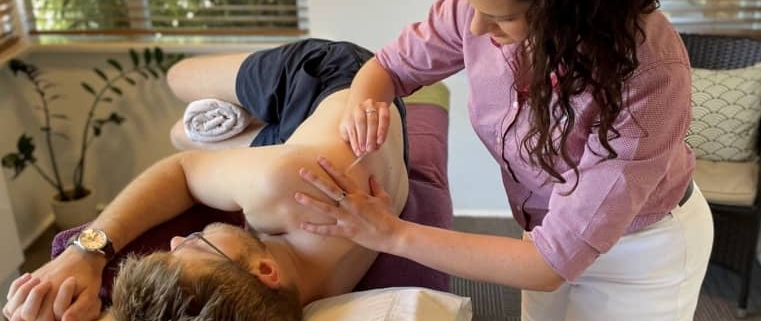How does Dry Needling work?
We are often asked by clients “how does dry needling work?”. Dry needling is a treatment technique that can be used to improve function of a muscle or decrease pain felt in the body. Dry needling can be used to initiate an immune response and change activation of nerve fibres.
What Is Dry Needling?
Dry needling is a practice used by allied health professionals that have been specifically trained in this technique. Dry needling is named as such to contrast with other types of “wet” needling, think injection of medicine or a tattoo needle.
Dry needling works by using a very thin, single use needle inserted into the body at specific locations depending on what the goal of treatment is. Western Dry Needling focuses on the release of muscle, ‘trigger points’ by inserting the needling directly into the targeted muscle. Eastern Dry Needling in directed by the understanding of meridian or energy lines to treat systemic issues.
The physiotherapists at Barefoot Physiotherapy primarily use western techniques though occasionally eastern techniques are used to support treatment as well.
What Does Dry Needling Do?
You may be wondering “what does dry needling do?”
Dry needling works to alter and improve our body’s capacity to move comfortably. It reduces tension in the muscle by changing the length of muscle fibres. It can decrease overall sensitivity of a muscle or body part. Dry needling can be used to decrease joint stiffness and increase joint movement. It can also be used to calm the overall nervous system of a body, decreasing the stress response that occurs on a mental and cellular level.
So, How Do Dry Needles Work?
How Does Dry Needling Work?
Dry needling works via five main effects:
- Peripheral (local) effects: initiates a local inflammatory response and release of local endorphins; increases local blood flow; causes a twitch and release response of muscle fibres via changes to calcium channels in the muscle fibres.
- Segmental (at the spinal cord) effects: pain gating where information from the needle insertion overrides other information from the area; enkephalin (endorphin) releases which acts as an internal Panadol osteo.
- Extra-segmental (at the brain) effects: releases serotonin, adrenaline and endogenous opioids to reduce pain felt in the whole body.
- Sympathetic effects: needling can stimulate the autonomic system and change sympathetic output.
- Immune effects: can support regulation of the immunoinflammatory process by release of endogenous opioids.
When to Use Dry Needling:
And when to use dry needling?
Dry needling can be used for a variety of injuries or concerns. Your physiotherapist may use this technique to help reduce swelling after an acute injury. It can reduce muscle spasm in a semi-acute flare up (e.g., back pain). We can use dry needling to assist in reducing headaches and stress. Dry needling techniques can be used to encourage tissue healing with persistent injuries such as a hamstring tendinopathy. It can be useful in reducing pain and swelling in knee osteoarthritis.
Dry needling is one of many techniques that we use at Barefoot Physiotherapy for the best management of your care. It may be used in addition to joint mobilisations, muscle self-releases and strengthening exercises.
How Does Dry Needling Help Chronic Injuries or Pain?
Dry needling for chronic injuries or pain uses a slightly different approach to dry needling for tight muscles. In chronic injuries or pain, we are wanting to have more systemic changes from our needling techniques. In this instance, we may use more gentle techniques where the needles are left inserted for a longer period of time. We may also use more traditional eastern techniques to support certain systems of the body. We can use eastern techniques with a western framework to provide a variety of stimuli to the area of focus without overwhelming the system while still changing the input to certain joints or muscles.
How Long Does Dry Needling Take to Work?
The timeframe for how long dry needling takes to work changes depending on the reason for using and the technique used. We are often asked, “how does dry needling work with different techniques?”
Pecking techniques where we seek a muscle twitch work immediately and continue with an increase local blood flow for an hour post treatment. A twitch response corresponds with immediate changes to muscle length. Sustained insertion of a dry needle can begin to make changes in as little as 1-10 minutes. Chemical reactions initiated via the insertion of the needle continue to last for up to 48 hours post treatment. You may need multiple sessions utilizing dry needling to gain the full benefit.
Is Dry Needling Painful?
We are often asked if dry needling is painful. There is often a little pinch or “mosquito bite” on the insertion of the needle. As the needle moves into the targeted area of muscle you may feel a dull ache, a slight grab or even a muscle twitch (involuntary muscle activation). The ache will usually subside after the needle has been inserted for a few minutes. Your physiotherapist will be communicating with you during this process. There is a small chance of ongoing sharpness or a zapping sensation. If this is the case the physiotherapy will alter the position of the needle. At Barefoot Physiotherapy we stay in the room with you while the needles are inserted and can adjust or answer questions at any time.
Book In with Barefoot for Dry Needling Today
Hopefully this blog has helped you gain a better understanding of dry needling and how it can be used. If you have questions about using dry needling as a component of your treatment, ask your physiotherapist. Book in with us today by calling us on 1300 842 850 or using the book online link on our website home page.








Leave a Reply
Want to join the discussion?Feel free to contribute!